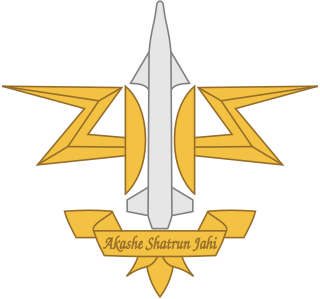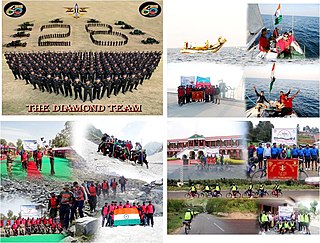
The Indian Army is the land-based branch and largest component of the Indian Armed Forces. The President of India is the Supreme Commander of the Indian Army, and its professional head is the Chief of Army Staff (COAS). The Indian Army was established on 1 April 1895 alongside the long established presidency armies of the East India Company, which too were absorbed into it in 1903. Some princely states maintained their own armies which formed the Imperial Service Troops which, along with the Indian Army formed the land component of the Armed Forces of the Crown of India, responsible for the defence of the Indian Empire. The Imperial Service Troops were merged into the Indian Army after independence. The units and regiments of the Indian Army have diverse histories and have participated in several battles and campaigns around the world, earning many battle and theatre honours before and after Independence.

The 11 Gorkha Rifles is a Gorkha regiment of the Indian Army that was re-raised after independence. The regiment consists of primarily the Kirant Tribes Rai, Limbu, Yakkha, Sunuwar of Eastern Nepal, Darjeeling, Kalimpong, Dooars of West Bengal, Sikkim and other parts of Northeast India. Though it is considered to be the youngest of the Gorkha regiments its lineage is as long as those of the 7th Gurkha Rifles and 10th Gurkha Rifles.

The Azad Kashmir Regiment, also known as AK Regt, is one of the six infantry regiments in the Pakistan Army. The regiment takes its name from Azad Kashmir, which is the Pakistani-administered territory of the Kashmir region. As per the order of seniority, it is the fourth regiment, but was the first to be raised after the independence of Pakistan from British colonial rule. Its regimental centre is located at Mansar camp in Attock District, on the border of Punjab and KPK provinces. The regiment has participated in all major and minor operations and wars fought by the army. Notable commanders of the regiment include lieutenant general Haroon Aslam, an ex-commander of Pakistan Army Special Service Group who led the SSG operation in Swat in 2009, and lieutenant general Hidayat ur Rehman, who commanded Operation al-Mizan and operation Zarb-e-Azab in FATA from 2014 to 2016.

The 16th Light Cavalry is a regiment of the Armoured Corps, a primary combat arm of the Indian Army. Prior to India gaining independence from the British in 1947, it was a regular cavalry regiment of the British Indian Army. It was formed in 1776 and is the oldest armoured regiment raised in India. The 16th Light Cavalry saw service in a number of conflicts ranging from the Second Anglo-Mysore War in 1781 to World War II. It has a number of battle honours including "Punjab 1965" earned during the Indo-Pakistani War of 1965.

The Battle of Burki was fought by Indian infantry and Pakistani armour in the Indo-Pakistani War of 1965. Burki is a village, that lies south-east of Lahore near the border with Punjab. For reference, that is just 11 km from the Allama Iqbal International Airport in Lahore, and is connected to Lahore by the a bridge over the Bambawali-Ravi-Bedian (BRB) Canal. During the battle, the strength of the two sides were relatively even. Indian infantry clashed with Pakistani forces that were entrenched in pillboxes, dug-outs and slit trenches that had been carved into the canal banks. The Pakistanis were supported by a large number of tanks, as well as fighter jets. The battle resulted in an Indian victory.

The Corps of Army Air Defence, is an active corps of the Indian Army and a major combat support arm tasked with air defence of the country from foreign threats. The AAD is responsible for the protection of Indian air space from enemy aircraft and missiles, especially below 5,000 feet.
20 SATA Regiment, nicknamed the ‘Alma Mater of Locators’ is a Surveillance and Target Acquisition (SATA) artillery regiment which is part of the Regiment of Artillery of the Indian Army.

75 Armoured Regiment is an armoured regiment of the Indian Army.
27 Air Defence Missile Regiment (Amritsar Airfield) is an Air Defence regiment of the Indian Army.

128 Air Defence Missile Regiment is an Air Defence regiment of the Indian Army.

9 Parachute Field Regiment is part of the Regiment of Artillery of the Indian Army.
29 Air Defence Regiment (Samba) is an Air Defence regiment of the Indian Army.

28 Air Defence Regiment is part of the Corps of Army Air Defence of the Indian Army.
130 Air Defence Regiment is part of the Corps of Army Air Defence of the Indian Army.
127 Light Air Defence Regiment (Composite) is part of the Corps of Army Air Defence of the Indian Army. It consists of 581, 582 and 583 Light Air Defence batteries.
47 Air Defence Regiment is part of the Corps of Army Air Defence of the Indian Army. It consists of 175, 176 and 177 air defence batteries.
49 Air Defence Regiment is part of the Corps of Army Air Defence of the Indian Army. It consists of 491, 492 and 493 air defence batteries.
151 Air Defence Regiment (Self Propelled) is part of the Corps of Army Air Defence of the Indian Army. It consists of 1511, 1512 and 1513 air defence batteries.
46 Air Defence Regiment is part of the Corps of Army Air Defence of the Indian Army.
103 Air Defence Regiment is part of the Corps of Army Air Defence of the Indian Army.









